The ultimate guide to germinating cannabis seeds

Whether you're a rookie grower or a seasoned cultivator, understanding the intricate process of cannabis seed germination is crucial for a successful grow. In this comprehensive guide, we'll unravel the mysteries of how tiny weed seeds burst to life and grow into the luscious plants we all love.
Contents:
- What happens during the germination of a cannabis seed?
- What are the different kinds of cannabis seeds?
- When and where to germinate cannabis seeds
- How long do cannabis seeds take to germinate?
- How to germinate weed seeds
- Seedling care — What to do after cannabis seed germination
- Why are my seeds taking so long to germinate?
- It's grow time!
Before we can harvest great bud, we need to grow healthy plants. And the key to healthy plants is germinating quality cannabis seeds and properly caring for the delicate seedlings they produce. Keep reading for an in-depth look at how cannabis seeds sprout, six different germination techniques, and tips on how to care for cannabis seedlings.
What happens during the germination of a cannabis seed?
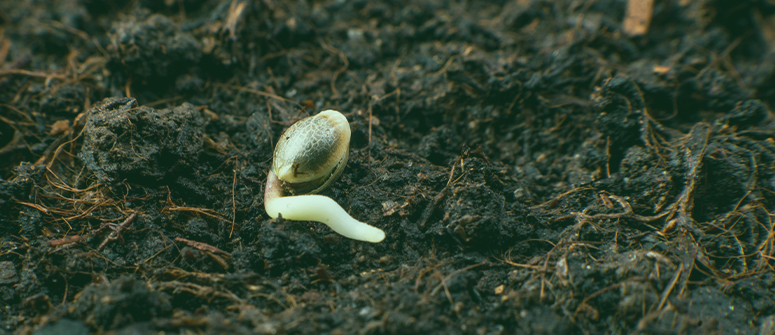
Growing cannabis from seed is a joy and has unique advantages over growing clones. However, germinating cannabis seeds can be tricky, especially for rookie growers.
Cannabis seeds sprout when they're exposed to the right environmental conditions. Initially, a seed will start absorbing oxygen and water, which causes the embryonic cell inside the seed to expand. Once the seed cracks, its taproot is able to emerge and push down into the soil. As the root grows and forms a shoot, it simultaneously pushes the seed out of the topsoil, allowing the plant's stem and cotyledons to emerge.
The main environmental conditions that need to be met in order for a seed to sprout are:
- High humidity: Cannabis seeds need to be able to absorb water, and sprout best in moist (but not drenched) soil.
- Oxygen: Cannabis seeds also need oxygen in order to pop and start growing.
- Temperature: The ideal temperature for seed germination is 21–27°C.
Once cannabis seeds sprout, proper lighting quickly becomes paramount. Freshly sprouted seedlings need light to fuel their growth and, most importantly, to avoid stretching. Cannabis seedlings that don't get enough light in the early stages develop long, leggy stems that can easily break, rather than developing healthy foliage to further fuel their growth.
What are the different kinds of cannabis seeds?
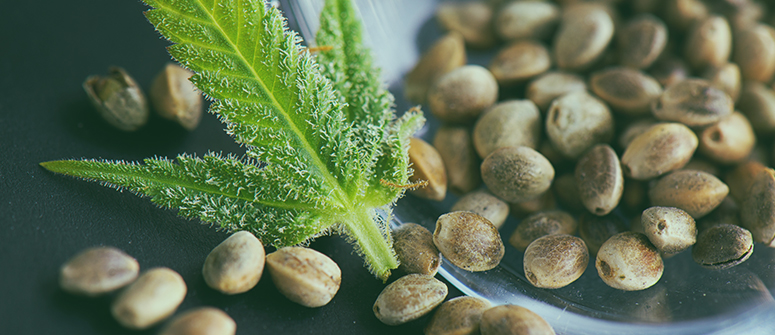
Cannabis seeds come in three main categories:
- Regular seeds: These are bred from male and female plants. Hence, they contain male and female chromosomes and can produce both male and female plants. Regular seeds are a great choice for breeders who want to have access to male cannabis pollen for their breeding projects. Typically (but not always), cannabis plants grown from regular seeds are photoperiodic, meaning they flower in response to light cycle changes.
- Feminized seeds: These seeds contain only female genetics and therefore only produce female plants. They are ideal for growers who want to harvest sinsemilla flower and need to minimise the risk of a stray male pollinating their females. Though the standard in feminized seeds is to grow photoperiodic plants, certain fem seeds can give rise to autoflowering plants.
- Autoflower seeds: Auto seeds produce plants that are day-neutral and flower automatically after a certain amount of veg time, rather than in response to light cycle changes. Plants grown from auto seeds are usually smaller than those grown from photoperiodic seeds and can't be aggressively trained. However, they are easy to grow, fast to flower, and usually come in a convenient feminized form. Auto seeds are ideal for those who want to get to harvest as fast as possible, those who live in cold regions with a short growing season, or those working with a small indoor grow space.
When and where to germinate cannabis seeds
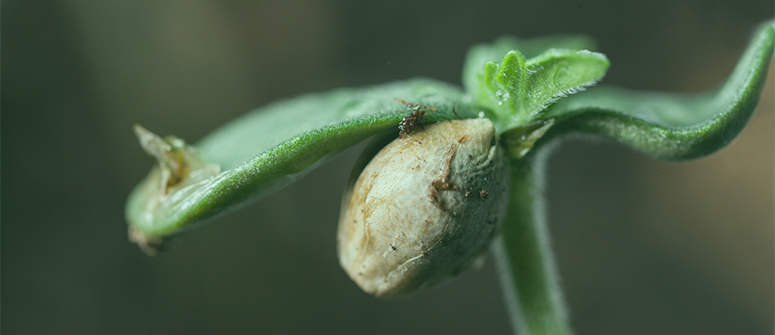
Cannabis seeds can take up to one week or more to germinate, so you'll need to account for this when planning your grow, especially outdoors, where you'll need to keep your local climate in mind. In general, we recommend germinating your seeds indoors, even if you plan to grow your plants outside. Cannabis seedlings are fragile, and starting them off indoors gives you more control over their environment to ensure each specimen gets a solid start in life.
Once your seedlings have developed their first sets of true leaves (that is, leaves with at least five fingers), you can slowly start bringing them outside to soak up the sun.
Will cannabis seeds germinate in a greenhouse?
Greenhouses strike the perfect balance between indoor and outdoor growing, allowing you to harness the power of the sun while still sheltering your plants from the cold or storms. It is also possible to germinate seeds and grow young seedlings in a greenhouse, as long as the conditions inside your greenhouse favour the conditions needed by seeds and very young plants.
How long do cannabis seeds take to germinate?
Cannabis seeds can take anywhere from 1–7 days to sprout, depending on the freshness of the seeds and the conditions they're exposed to. Fresh, young seeds can sprout within 24–48 hours, while older seeds may have a harder shell and need more time to pop. In some cases, seeds can take up to (or over) two weeks to sprout.
How to germinate weed seeds
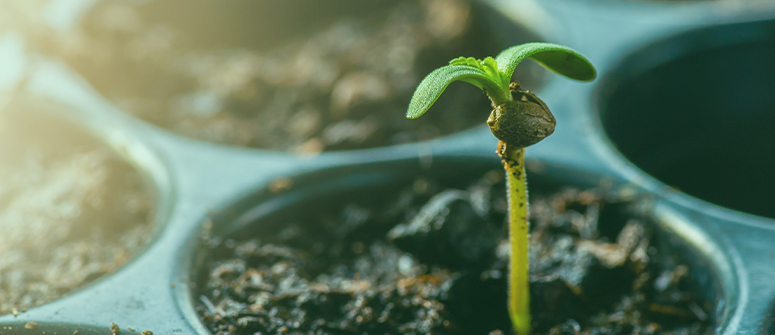
There's no single correct way to germinate cannabis seeds—it's all about finding a method that suits you. Below, we'll walk you through the ins and outs of different cannabis seed germination techniques, from simply burying seeds in soil to sprouting them in pellets and more.
Preparation
Before you start germinating your seeds, it's important to do some prep work—namely, checking the viability of your seeds and preparing the environment in which you'll keep your seedlings.
How to test the viability of cannabis seeds
Healthy cannabis seeds should have a hard outer shell and a pale brown colour with dark brown or black patches/stripes—reminiscent of tortoiseshell or tiger stripes. They also tend to have a waxy sheen that gradually fades as the seeds get older. Older seeds also take on darker colours and become very hard. Immature seeds, on the other hand, are typically pale white or green in colour with a soft shell. Both immature and old cannabis seeds usually don't have good germination rates.
Some growers suggest the size and shape of a seed to be indicative of its health, but there's no evidence to support that this is true. In fact, the shape and size of seeds can vary from one strain to another.
Finally, healthy seeds should sink if submerged in water, as they're naturally heavier and denser than water. Next time you want to test the freshness of your seeds, put them in a glass of water and wait 1–2 hours—the seeds that have sunk to the bottom of the glass probably have the best chance of germinating.
A note on damaged seeds: cannabis seeds can sometimes get damaged during shipping or transporting. Seeds with a slightly ruptured shell may still germinate, so don't be too quick to discard them.
How to create the perfect environment for cannabis seedlings
Cannabis seedlings are super fragile, so it's important they're exposed to the correct conditions as soon as they pop out of the ground. Propagators or plastic domes that trap moisture and warmth are great for weed seedlings. Some propagators also come with cool CFL lights that are ideal for this early stage of growth and will prevent seedlings from stretching.
Alternatively, cannabis seedlings also grow well on bright windowsills. Just remember to mist them regularly with clean water, and keep them warm and out of reach of kids and pets. Also, remember to keep your seedlings in an area with a healthy exchange of oxygen and carbon dioxide.
How to germinate cannabis seeds directly in the medium
Many growers prefer to sprout their cannabis seeds just the way nature intended—directly in the growing medium. This method tends to work the best in soil grows, as good-quality soil can retain a lot of water while staying aerated, and contains microorganisms that help to promote root growth. However, germinating seeds directly in non-soil-based media, such as coco coir, is much more challenging.
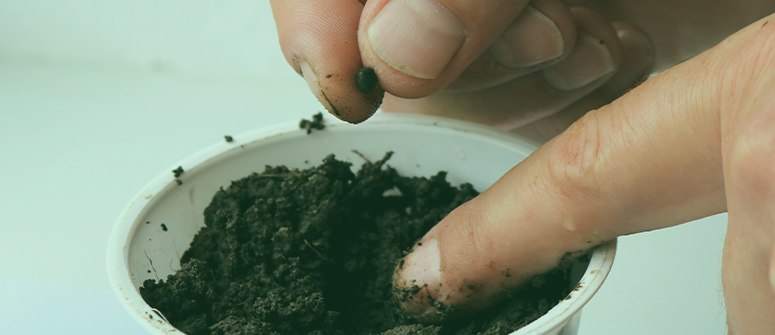
Directions:
- Wet your growing medium liberally. It should feel wet to the touch, but not look drenched or soaked.
- Stick your finger into the medium to create a 1–2cm-deep hole.
- Place your seed inside the hole and lightly cover it with soil.
- Keep the medium wet and warm until you see your seedling pop out of the medium.
How to germinate cannabis seeds using Jiffy Pellets
Jiffy Pellets, or similar products, are made from peat and are specially designed for seedlings. Some growers like to germinate their seeds directly in pellets because they sometimes come pre-fertilised with nutrients and rooting agents that promote germination and root growth. Moreover, seed pellets are well-aerated, ensuring that your seeds/seedlings get enough oxygen. Unfortunately, pellets also dry out quickly, making it a lot easier for your seeds to dry out, often resulting in stunted seedling growth, and sometimes even the death of a seed.
Directions:
- Wet your Jiffy Pellets.
- Pop a seed into the top of each pellet.
- Make sure your pellets don't dry out. Regular mist, or place your pellets in a tray with 1–1.5cm of water.
How to germinate cannabis seeds in paper towels
This is by far one of the most popular seed germination methods used by cannabis growers. And for good reason—it's simple and produces good results. Moreover, it allows you to regularly monitor your seeds, which isn't possible when germinating seeds directly in the medium or a seed pellet.
Directions:
- Line a plate with 2–4 sheets of paper towel.
- Wet the paper, making sure it's completely wet but not soaked.
- Place your seeds on top of the paper.
- Cover with another 2–4 sheets of wet paper towel followed by an upside-down bowl or plate.
- Check on your seeds daily, making sure the paper doesn't dry out.
- Once your seeds have popped and developed a 2–3cm-long taproot, transfer them to their pots.
How to germinate cannabis seeds in a glass of water
Some growers opt to activate their seeds this way, especially when trying to germinate old seed stock, as the water helps to loosen up the seed husk, making it easier for the embryonic cell to break through the seed wall.
Directions:
- Fill a glass with water. While not necessary, adding some hydrogen peroxide to the water (3–5 drops per 100ml ) can help to break down seed shells and speed up the germination process.
- Place your seeds in the water.
- Let them soak for a maximum of 12 hours.
- Transfer the soaked seeds to moist soil or paper towels.
- Wait for your seeds to sprout, making sure they do not dry out.
How to germinate cannabis seeds in cotton wool
This method is similar to the paper towel method, and just as successful. Like paper towels, cotton wool is very effective at retaining moisture and heat while still respiring. To help fast-track germination, soak the cannabis seeds first before following the directions below.
Directions:
- Stick your seed inside some wet cotton wool.
- Place the wool on a plate and cover with an upside-down plate or bowl.
- Keep the wool wet until the seeds sprout and have a 2–3cm-long taproot.
- Transfer the germinated seeds to their pots.
How to germinate cannabis seeds with a starter kit
Some cannabis seed banks sell starter kits that contain all the necessary equipment needed to properly germinate seeds. While the actual content of these kits may vary from one brand to another, they usually contain:
- Small pots with starter soil specially formulated for seedlings.
- Rooting hormone or bacteria designed to promote faster germination and root growth.
- A dome or propagator.
Simply follow the instructions that come with the kit, and be sure to regularly mist your seedlings and closely monitor the temperature/humidity in their grow space.
Can you germinate cannabis seeds in Rockwool?
Rockwool, aka stone wool, is often used in hydro systems, where it serves as a dense, inert medium for cannabis roots. We do not recommend using it as a germination medium, however, as it is neither biodegradable nor sustainable, has a high pH that isn't suitable for cannabis (stone wool is naturally alkaline), and can contain fibres and dust that may contaminate your seeds and prove hazardous to your health if inhaled during handling.
If you do choose to use Rockwool for germination, make sure to follow the steps below.
Directions:
- Fill a container with water and measure its pH.
- Use pH-down solution to bring the water's pH to 5.5.
- Soak your Rockwool cubes in the solution for 24 hours.
- Push your seeds roughly 1–2cm deep into the cubes. If the stone wool you're using is too dense, it may help to make a small cut into the top of the cubes to house the seeds.
- Keep the cubes moist until your seedlings sprout.
Seedling care — What to do after cannabis seed germination
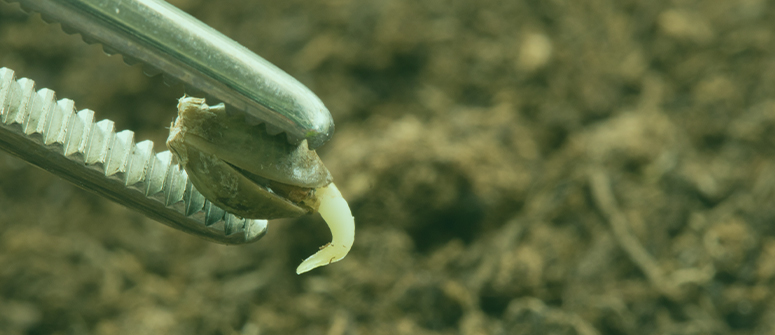
Once your seeds germinate, you're officially the proud owner of cannabis seedlings. And while the seedling phase is arguably one of the most challenging of the cannabis growing cycle, there are a few things you can do to make this stage as smooth as possible, including:
- Proper lighting: Cannabis seedlings thrive under CFL lights. Hang a CFL lamp 15cm above the tops of your seedlings to promote healthy early growth without the risk of burning or stressing your young plants.
- Good-quality medium: Cannabis seedlings like well-aerated, moist media that facilitate the growth of their roots. If you're new to growing weed, we recommend starting in soil before trying your hand at more complex soilless setups.
- Misting: Seedlings have really delicate root systems that are easy to drown. In the early stages of the seedling phase, it can be better to mist your plants and their topsoil with a spray bottle rather than trying to water them with a stream.
- Feeding: When growing in soil, cannabis seedlings usually won't need to be fed for two weeks (or even longer if you're growing in organic super soil). When growing in coco, you might want to start feeding your plants after 1–2 weeks, while inert media might call for earlier feeding.
- Watering: Once your seedlings are a little stronger, you can start watering them in a circle roughly 3cm from their stem. This will encourage their roots to grow out towards the edges of their pots and form a strong, healthy root system.
Why are my seeds taking so long to germinate?
As mentioned earlier, cannabis seeds can take anywhere between 24 hours and two weeks to sprout, depending on the health and age of the seeds. If your seeds are taking longer than expected, check your germination method and ensure you're providing your seeds with the right conditions to promote germination.
Unfortunately, not all cannabis seeds germinate. If you're confident that you're using a good germination method and giving your seeds the right conditions, consider tossing your seeds and trying to germinate a new batch. If you ordered your seeds from a seed bank, contact the company and tell them of your problems. Respected seed banks pride themselves on their high germination rates, and may offer to replace your seeds.
If you intend to store cannabis seeds for a long time, make sure to do so in a way that optimises their quality and longevity.
It's grow time!
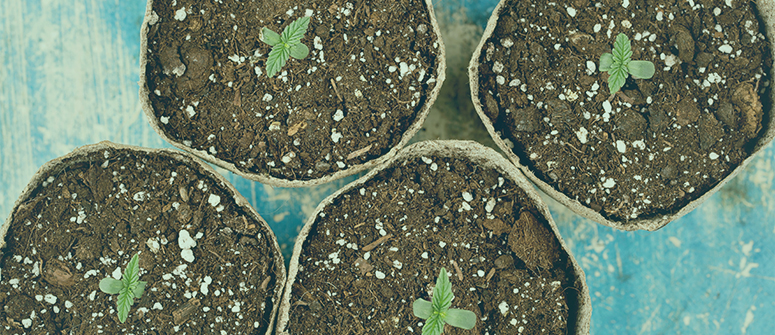
Now that you're armed with all the know-how regarding cannabis seed germination and caring for seedlings, what are you waiting for? Grab your seeds, get into the garden, and get growing! If you're not sure which germination method to try, we recommend germinating seeds in paper towels or cotton wool first. But feel free to experiment with other methods and see what best suits you. Finally, don't forget that it's also possible to grow cannabis from clones rather than seeds.




